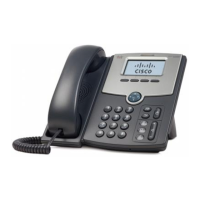
Do you have a question about the Cisco SPA 502G and is the answer not in the manual?
Explains using the handset, speaker, or headset for calls and dialing assistance via LCD.
Describes how the LCD screen displays matching numbers during dialing and using the navigation pad.
Details how the four buttons below the LCD screen act as soft keys with dynamic functions.
Outlines the default soft key arrangement (GPickUp, dir, dnd, redial, cfwd) when the phone is inactive.
Explains how to pick up another group member's ringing call using the GPickUp soft key.
Describes accessing local, company, and personal phone directories via the 'dir' soft key.
Details how to set the phone to unavailable for incoming calls using the 'dnd' soft key.
Explains accessing a list of recently dialled numbers with date, time, and duration using 'redial'.
Describes setting up call forwarding to another number using the 'cfwd' soft key.
Explains the 'answer' and 'ignore' soft key options available when a call is received.
Details the soft key options (dial, delChr, clear, cancel, etc.) available when dialing a number.
Describes the 'hold', 'endCall', 'conf', 'xfer', 'bxfer' soft keys available once a call is connected.
Explains how to place a call on hold using the 'hold' soft key and resume it later.
Details how to initiate and manage a three-party conference call using the 'conf' soft key.
Explains Attended (xfer) and Unattended (xfer) call transfers, and Blind Transfer (bxfer).
Describes how to check for new messages via the Message Waiting Indicator and Voice mail button.
Lists options for listening, replying, forwarding, and managing voice messages.
Explains accessing call history (made, received, missed) and managing entries like delete, edit, save.
Details how to change the ring tone for each line using the Setup button and soft keys.